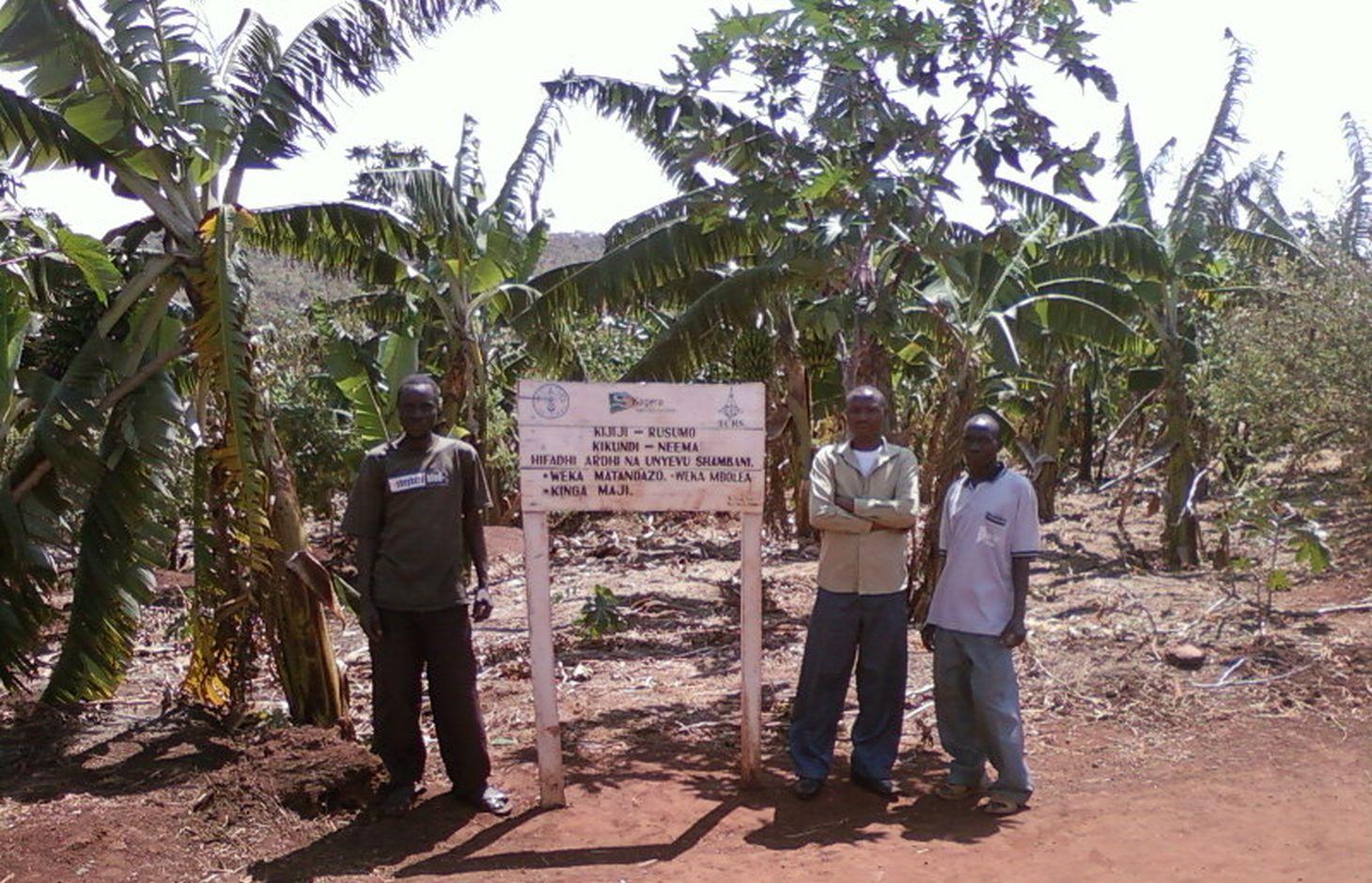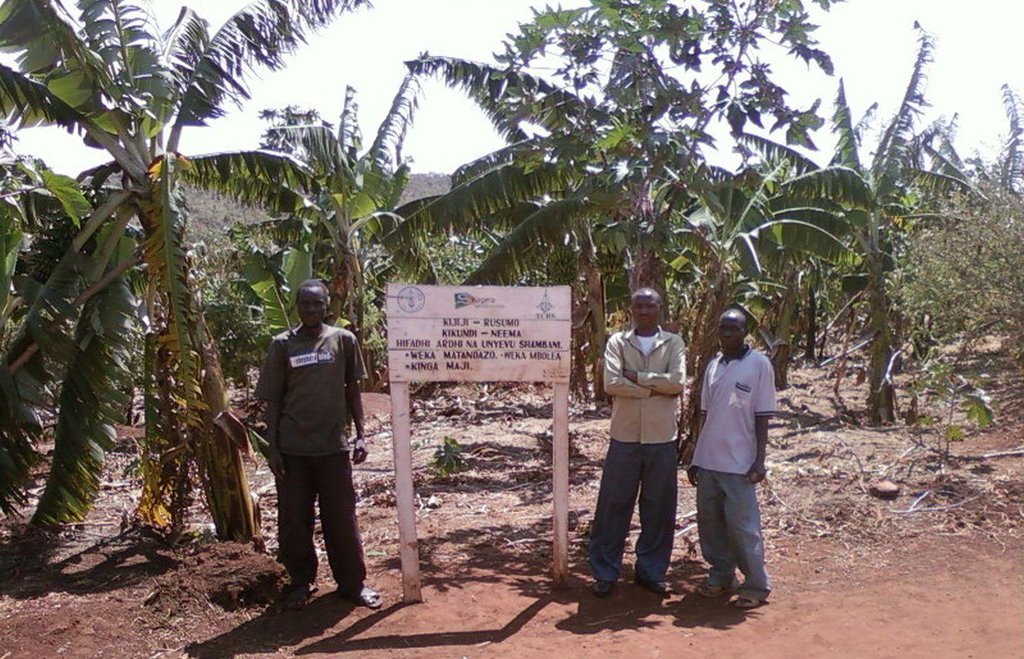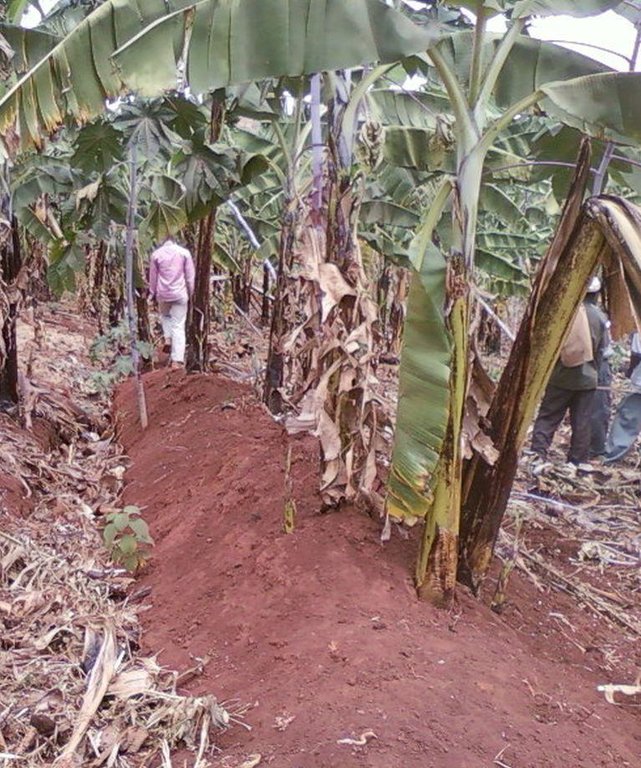Cross slope berier characterised with furrow, bund, cajanus cajan, pinepples, farm yard manures and grass mulch in banana production [坦桑尼亚联合共和国]
- 创建:
- 更新:
- 编制者: Godfrey Baraba
- 编辑者: –
- 审查者: Deborah Niggli, Alexandra Gavilano
Fanya chin fanya juu
technologies_1232 - 坦桑尼亚联合共和国
- Cross slope berier characterised with furrow, bund, cajanus cajan, pinepples, farm yard manures and grass mulch in banana production: Jan. 5, 2017 (inactive)
- Cross slope berier characterised with furrow, bund, cajanus cajan, pinepples, farm yard manures and grass mulch in banana production: Aug. 6, 2019 (public)
查看章节
全部展开 全部收起1. 一般信息
1.2 参与该技术评估和文件编制的资源人员和机构的联系方式
SLM专业人员:
1.3 关于使用通过WOCAT记录的数据的条件
编制者和关键资源人员接受有关使用通过WOCAT记录数据的条件。:
是
1.4 所述技术的可持续性声明
这里所描述的技术在土地退化方面是否存在问题,导致无法被认为是一种可持续的土地管理技术?:
否
2. SLM技术的说明
2.1 技术简介
技术定义:
Is the cross slope berrier charactrised by contour bunds, cajanus can, pineapples, farm yard manures and grass mulch in banana production.
2.2 技术的详细说明
说明:
The contour band stabilized with cajanus cajan and pineapples in the composite manures and trushline application technology is the digging of a 0.6m wide by 0.6m deep along the demarcated contour line, while two rows of cajanus cajan planted along the band spaced at 0.3m and two rows of pineapples at alternating band spaced at 0.3m. The overall purpose of the technology is to reduce soil erosions while increasing soil water infiltration and retaining soil water moisture. The technology is applied perennial cropland in the sub humid climatic zone on the gentle to moderate slope, loam soils with medium soil depth. The technology is done manually using hand hoes and mattock in a mixed production system, land owned individually not titled while the total cost to implement a technology on 0.2ha in the banana field was calculated to be US$ …..
The purpose is to increase land productivity, improve livelihood as well as improved ecosystem and micro climate. This should be attained by improving water use efficiency, soil fertility inprovement to increase crop productivity and generating incomes.
The establishment procedures require the determination of the slope and demarcation of a contour line using a tool known as A-frame. This is done manually during the rainy season. The digging and excavation of the soils is done at the end of harvesting annual crops (bean and maize) using hand hoes manually. The cajanus cajan seeds are sown in two rows along the band and the next band is planted with two rows of pinepples at 0.3m between rows as well as between plants. The shallow ditch measuring 0.6m by 0.6m is excavated at the centre of four banana stools to collect crop residues to decompose and apply them. Old banana stools are up rooted at the end of rain season while measurements and digging of holes done. The spacing is 3.6m by 3.6m for the planted medium variety. The hole measurements is 0.6m width by 0.6m length by 0.3m depth. The farmyard manures are mixed with top soils and covered in the hole for three months before planting. The planting is done before the onset of rainfalls. The dry grass mulch is applied across the slope with a thickness of 0.15m at the onset of rainfalls.
The maintenance procedures require the remove of sedments at the end of rainseason done manually using spades. The trimming of cajanus cajan and pineapples are done manually during the harvesting season. Desuckering and detrushing of banana plants are done twice after harvesting annual crops while grass mulch followed.
Average annual rainfall (750 to 1,000)mm, Altitude (m a.s.l.) (1,000 -1,500)m Landform is hill slope to foot slope, Soil depth (>20 cm) shallow about 20%, (20-50cm) medium about 60% and (50-80cm) deep about 20%, Soil water storage capacity: medium, Soil texture: medium (loam), Soil fertility: low, Topsoil organic matter: medium (1-3%) and Soil drainage/infiltration: medium. Cropland per household is 2-5 ha, Land user are Individual / household, Small scale land users, common / average land users, men and women. Population density: 200-500 persons/km2, Annual population growth: < 0.5%, Land ownership: individual, not titled Land use rights: individual, Water use rights: open access (unorganised) Relative level of wealth: rich, which represents 5% of the land users; 21% of the total area is owned by rich land users average, which represents 64% of the land users; 64% of the total area is owned by average land users poor, which represents 21% of the land users; 5% of the total area is owned by poor land users Market orientation: mixed (subsistence and commercial) Mechanization: manual labour
2.3 技术照片
2.5 已应用该技术的、本评估所涵盖的国家/地区/地点
国家:
坦桑尼亚联合共和国
区域/州/省:
Tanzania
有关地点的进一步说明:
Ngara District Council
具体说明该技术的分布:
- 均匀地分布在一个区域
如果不知道精确的区域,请注明大致覆盖的区域:
- < 0.1 平方千米(10 公顷)
注释:
Three host farmers isued 1.5 acres as site implimentation other 32 group members required to do what they learned at their homes.
2.6 实施日期
如果不知道确切的年份,请说明大概的日期:
- 不到10年前(最近)
2.7 技术介绍
详细说明该技术是如何引入的:
- 通过项目/外部干预
注释(项目类型等):
The technology was introduced in 2012 using FFS metodology (at host farmer sites) and results demonstration (at FEC) as a choice of technology.
3. SLM技术的分类
3.1 该技术的主要目的
- 改良生产
- 减少、预防、恢复土地退化
3.2 应用该技术的当前土地利用类型

农田
- 一年一作
- 多年一作(非木材)
年作 - 具体指明作物:
- 谷物类 - 玉米
- 豆科牧草和豆类 - 豆子
多年生(非木质)作物 - 指定作物:
- 香蕉/芭蕉/蕉麻
- 菠萝
- cajanus cajan
每年的生长季节数:
- 2
具体说明:
Longest growing period in days: 120, Longest growing period from month to month: September to December; Second longest growing period in days: 90, Second longest growing period from month to month: March to May
注释:
Major land use problems (compiler’s opinion): The major land use problem relatrd to soil, water and vegetation in the area without conservation was loss of soil water moisture, reduced soil nutrients and soil erosion.
Major land use problems (land users’ perception): The major land use problem related to soil, water and vegetation without conservation was declining soil productivity.
3.4 供水
该技术所应用土地的供水:
- 雨养
3.5 该技术所属的SLM组
- 横坡措施
3.6 包含该技术的可持续土地管理措施

农艺措施
- A2:有机质/土壤肥力

植物措施
- V2:草和多年生草本植物

结构措施
- S2:堤、岸
注释:
Type of agronomic measures: mulching, legume inter-planting, manure / compost / residues
Type of vegetative measures: aligned: -contour, aligned: -linear
3.7 该技术强调的主要土地退化类型

土壤水蚀
- Wt:表土流失/地表侵蚀

化学性土壤退化
- Cn:肥力下降和有机质含量下降(非侵蚀所致)

生物性退化
- Bq:数量/生物量减少
- Bl:土壤寿命损失
注释:
Main causes of degradation: soil management (Cultivation along the slope), disturbance of water cycle (infiltration / runoff) (cultivation along the slope), change of seasonal rainfall (un determined rainfall parterns), droughts (the area normally experiences a long dry spell of about 290 days), population pressure (croping along the slope and natural forests), poverty / wealth (Land user can not afford to invest in land conservation), education, access to knowledge and support services (lInadequate staffing to diseminate technology massages.), governance / institutional (weak environmental law inforcements and lack of community sensitization..)
3.8 防止、减少或恢复土地退化
具体数量名该技术与土地退化有关的目标:
- 防止土地退化
- 减少土地退化
4. 技术规范、实施活动、投入和成本
4.1 该技术的技术图纸
技术规范(与技术图纸相关):
Furrow measurements is 0.6m wide by 0.6m deep across the slope; space between the structure is 18m, banana space is 3.6m by 3.6m; grass mulch thickness is 0.15m and composite is prepared at the center of four banana stools to be applied topically in the shallow furrow towards the grand daughter banana sacker.
Location: Rwabilulu sub village, Rusumo village. Ngara/Kagera/Tanzania
Date: 25/07/2014
Technical knowledge required for field staff / advisors: low (The technology basic principles are taught at colleges.)
Technical knowledge required for land users: moderate (Slope measurements and use of A-frame is a new idea to land users .)
Main technical functions: control of raindrop splash, control of dispersed runoff: retain / trap, control of dispersed runoff: impede / retard, reduction of slope length, stabilisation of soil (eg by tree roots against land slides), increase in organic matter, increase in nutrient availability (supply, recycling,…), increase of infiltration, increase / maintain water stored in soil
Secondary technical functions: control of concentrated runoff: retain / trap, increase of biomass (quantity)
Mulching
Material/ species: grass mulch
Quantity/ density: 1500
Remarks: spread across the slope with thckess 0.15m
Legume inter-planting
Quantity/ density: 0.25
Remarks: dibling betwen the structure
Manure / compost / residues
Material/ species: composite manures
Quantity/ density: 0.036
Remarks: mixed with soil in shallow furrow facing the grand daughter banana sucker
Aligned: -contour
Vegetative material: F : fruit trees / shrubs, O : other
Number of plants per (ha): 35
Aligned: -linear
Vegetative material: C : perennial crops
Number of plants per (ha): 714
Trees/ shrubs species: perennial fodder
Perennial crops species: banana
Other species: pinepples
Construction material (earth): excavated soils
Slope (which determines the spacing indicated above): 2%
Vegetation is used for stabilisation of structures.
作者:
Baraba Godfrey, C/O DED Bukoba, P.O.BOX 491 Bukoba, Tanzania
4.2 有关投入和成本计算的一般信息
其它/国家货币(具体说明):
TShs.
如相关,注明美元与当地货币的汇率(例如1美元=79.9巴西雷亚尔):1美元=:
1700.0
注明雇用劳工的每日平均工资成本:
2.06
4.3 技术建立活动
| 活动 | 时间(季度) | |
|---|---|---|
| 1. | Ploughung | once at the end of short rainfals |
| 2. | Harrowing | Mid of dry spel |
| 3. | Spacing and demarcating holes | mid of dry spel |
| 4. | Digging holes | mid of dry spel |
| 5. | mixing farm yard manures | mid of dry spel |
| 6. | Planting banana suckers | lat dry spale |
| 7. | Sowing cajanus cajan | on set of long rainfals |
| 8. | Planting pinepples | on sertof long rainfals |
| 9. | To demarcate contour line | the end of short rainfall |
| 10. | To dig the furrow | at the end of dry spel |
4.4 技术建立所需要的费用和投入
| 对投入进行具体说明 | 单位 | 数量 | 单位成本 | 每项投入的总成本 | 土地使用者承担的成本% | |
|---|---|---|---|---|---|---|
| 劳动力 | labour | ha | 1.0 | 1696.85 | 1696.85 | |
| 设备 | tools | ha | 1.0 | 4.71 | 4.71 | 100.0 |
| 植物材料 | seedlings | ha | 1.0 | 433.89 | 433.89 | |
| 技术建立所需总成本 | 2135.45 | |||||
| 技术建立总成本,美元 | 1.26 | |||||
注释:
Duration of establishment phase: 12 month(s)
4.5 维护/经常性活动
| 活动 | 时间/频率 | |
|---|---|---|
| 1. | weeding | Twice in the midle of rainfals |
| 2. | Desuckering | Twice in the midle of rainfals |
| 3. | Detrushing | Twice in the middle rainfals |
| 4. | Mulching | once at the end of dry spel |
| 5. | Banana weevils trapping | routenely |
| 6. | manures appliacation | at the end od dry spel |
| 7. | Sowing beans | once in the long rainfals |
| 8. | To prune cajanus cajan | routenly |
| 9. | To remove soil sediment | twice at the end of raifals |
4.6 维护/经常性活动所需要的费用和投入(每年)
| 对投入进行具体说明 | 单位 | 数量 | 单位成本 | 每项投入的总成本 | 土地使用者承担的成本% | |
|---|---|---|---|---|---|---|
| 劳动力 | labour | ha | 1.0 | 205.88 | 205.88 | 100.0 |
| 技术维护所需总成本 | 205.88 | |||||
| 技术维护总成本,美元 | 0.12 | |||||
注释:
The costs for agronomic measures calculated per 0.2 hectors the converted to per hectare. The costs for vegetative calculated per number of plants in 0.2 ha the converted per hectare and the costs for structural measures calculated per total length of structures foun in 0.2 ha then converted per hectare,
4.7 影响成本的最重要因素
描述影响成本的最决定性因素:
The most determinate factors are labour light indicating the technology to be labour intensive in nature.
5. 自然和人文环境
5.1 气候
年降雨量
- < 250毫米
- 251-500毫米
- 501-750毫米
- 751-1,000毫米
- 1,001-1,500毫米
- 1,501-2,000毫米
- 2,001-3,000毫米
- 3,001-4,000毫米
- > 4,000毫米
有关降雨的规范/注释:
long rains September to December, short rainsMarch to May.
农业气候带
- 半湿润
Thermal climate class: tropics
5.2 地形
平均坡度:
- 水平(0-2%)
- 缓降(3-5%)
- 平缓(6-10%)
- 滚坡(11-15%)
- 崎岖(16-30%)
- 陡峭(31-60%)
- 非常陡峭(>60%)
地形:
- 高原/平原
- 山脊
- 山坡
- 山地斜坡
- 麓坡
- 谷底
垂直分布带:
- 0-100 m a.s.l.
- 101-500 m a.s.l.
- 501-1,000 m a.s.l.
- 1,001-1,500 m a.s.l.
- 1,501-2,000 m a.s.l.
- 2,001-2,500 m a.s.l.
- 2,501-3,000 m a.s.l.
- 3,001-4,000 m a.s.l.
- > 4,000 m a.s.l.
5.3 土壤
平均土层深度:
- 非常浅(0-20厘米)
- 浅(21-50厘米)
- 中等深度(51-80厘米)
- 深(81-120厘米)
- 非常深(> 120厘米)
土壤质地(表土):
- 中粒(壤土、粉土)
表土有机质:
- 中(1-3%)
- 低(<1%)
5.6 应用该技术的土地使用者的特征
生产系统的市场定位:
- 混合(生计/商业)
非农收入:
- 低于全部收入的10%
个人或集体:
- 个人/家庭
机械化水平:
- 手工作业
性别:
- 女人
- 男人
说明土地使用者的其他有关特征:
Land users applying the Technology are mainly common / average land users
Population density: 200-500 persons/km2
Annual population growth: < 0.5%
Relative level of wealth: rich, average, poor
5% of the land users are rich and own 21% of the land.
64% of the land users are average wealthy and own 64% of the land.
21% of the land users are poor and own 5% of the land.
Off-farm income specification: Increased crop productivity from the use of technology has revealed excess crop produce for sale and sustain the house hold solely fro farm income.
5.7 应用该技术的土地使用者使用的平均土地面积
- < 0.5 公顷
- 0.5-1 公顷
- 1-2 公顷
- 2-5公顷
- 5-15公顷
- 15-50公顷
- 50-100公顷
- 100-500公顷
- 500-1,000公顷
- 1,000-10,000公顷
- > 10,000公顷
这被认为是小规模、中规模还是大规模的(参照当地实际情况)?:
- 小规模的
5.8 土地所有权、土地使用权和水使用权
土地所有权:
- 个人,未命名
土地使用权:
- 个人
用水权:
- 自由进入(无组织)
5.9 进入服务和基础设施的通道
健康:
- 贫瘠
- 适度的
- 好
教育:
- 贫瘠
- 适度的
- 好
技术援助:
- 贫瘠
- 适度的
- 好
就业(例如非农):
- 贫瘠
- 适度的
- 好
市场:
- 贫瘠
- 适度的
- 好
能源:
- 贫瘠
- 适度的
- 好
道路和交通:
- 贫瘠
- 适度的
- 好
饮用水和卫生设施:
- 贫瘠
- 适度的
- 好
金融服务:
- 贫瘠
- 适度的
- 好
6. 影响和结论性说明
6.1 该技术的现场影响
社会经济效应
生产
作物生产
SLM之前的数量:
5
SLM之后的数量:
24
注释/具体说明:
banana
收入和成本
农业投入费用
注释/具体说明:
costs of manures, certified banana suckers
农业收入
注释/具体说明:
sales of excess banana, beans and pinepples.
收入来源的多样性
SLM之前的数量:
0
SLM之后的数量:
1
注释/具体说明:
sales of beans and pinepples
工作量
注释/具体说明:
additonal activities at the sama season.
社会文化影响
食品安全/自给自足
注释/具体说明:
Household devoted labor to invrease productivity.
社区机构
注释/具体说明:
working as group on the training sites.
国家机构
注释/具体说明:
private service providers participation in project implementation.
SLM/土地退化知识
注释/具体说明:
group members attended FFS
冲突缓解
SLM之前的数量:
0
SLM之后的数量:
25
社会经济弱势群体的情况
注释/具体说明:
group formation considered gender equality
contribution to human well-being
注释/具体说明:
The technology maturity age of 18 months is too young to measure the livelihood indicators, though a positive perception is at hand.
生态影响
水循环/径流
地表径流
注释/具体说明:
contour
多余水的排放
注释/具体说明:
contour
蒸发
注释/具体说明:
grass mulch
土壤
土壤水分
注释/具体说明:
grass mulch
土壤覆盖层
注释/具体说明:
grass mulch
土壤流失
注释/具体说明:
grass mulch to prevent soil erosion
养分循环/补给
注释/具体说明:
cajanus cajan
土壤有机物/地下C
注释/具体说明:
composite manures application
生物多样性:植被、动物
生物量/地上C
注释/具体说明:
grass mulch
减少气候和灾害风险
碳和温室气体的排放
注释/具体说明:
Composite manure utilization
6.2 该技术的场外影响已经显现
下游洪水
注释/具体说明:
The area is too small to show the effects.
对邻近农田的破坏
注释/具体说明:
grass mulch retrds water run-off
对公共/私人基础设施的破坏
6.3 技术对渐变气候以及与气候相关的极端情况/灾害的暴露和敏感性(土地使用者认为的极端情况/灾害)
渐变气候
渐变气候
| 季节 | 增加或减少 | 该技术是如何应对的? | |
|---|---|---|---|
| 年温度 | 增加 | 未知 |
气候有关的极端情况(灾害)
气象灾害
| 该技术是如何应对的? | |
|---|---|
| 局地暴雨 | 好 |
气候灾害
| 该技术是如何应对的? | |
|---|---|
| 干旱 | 好 |
水文灾害
| 该技术是如何应对的? | |
|---|---|
| 比较和缓的(河道)洪水 | 不好 |
注释:
The technology could be modified by introducing the water spillways in heavy rainfalls and collect the water in reservor to be used during the dry spells.
6.4 成本效益分析
技术收益与技术建立成本相比如何(从土地使用者的角度看)?
短期回报:
轻度消极
长期回报:
积极
技术收益与技术维护成本/经常性成本相比如何(从土地使用者的角度看)?
短期回报:
轻度消极
长期回报:
稍微积极
注释:
The cumulative accrues for three years should cover the establishment costs and while for the long period there will be no further establishments.
The maintenance costs for the first three years is greater than the returns while in the long run the increased productivity should overdue the maintenance costs.
6.5 技术采用
在所有采用这项技术的人当中,有多少人是自发的,即未获得任何物质奖励/付款?:
- 51-90%
注释:
12% of land user families have adopted the Technology with external material support
25 land user families have adopted the Technology with external material support
Only 3 host farners out of 25 total group members were supplied of certified banana suckers and grass mulch.
88% of land user families have adopted the Technology without any external material support
25 land user families have adopted the Technology without any external material support
23 group members were adopted with modification the technology at there own full costs.
There is a little trend towards spontaneous adoption of the Technology. The adoption with modification is high, but these modification tends to diverge from the SaLM though productivity is attained.
6.7 该技术的优点/长处/机会
| 编制者或其他关键资源人员认为的长处/优势/机会 |
|---|
| Increased land productivity: The furrow has increased water infiltration and reduced blue water evaporation.Cajanus cajan has stabilised the soil on the riser while improving nutrient cycling. Certified banana suckers has reduced production failure. micro climate |
| Improved livelihood: Increased banana productivity form 4 tones per hectare to 9 tones per hectare should ensure food security as well as income. |
| Improved ecosystem: prevent, mitigate and rehabilitate degradation |
| The technology is easy to learn and apply. |
6.8 技术的弱点/缺点/风险及其克服方法
| 编制者或其他关键资源人员认为的弱点/缺点/风险 | 如何克服它们? |
|---|---|
| Increased labour constraints to dig and excavate the furrow. | Reduce out migration of labour. |
| Increased farm input costs to purchase certified banana suckers and cajanus cajan seeds. | Establish banana nursries at local levels. |
7. 参考和链接
7.1 信息的方法/来源
- 实地考察、实地调查
- 与土地使用者的访谈
(现场)数据是什么时候汇编的?:
25/07/2014
链接和模块
全部展开 全部收起链接
无链接
模块
无模块




